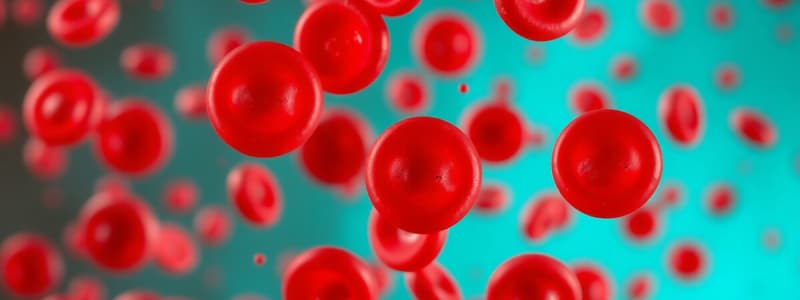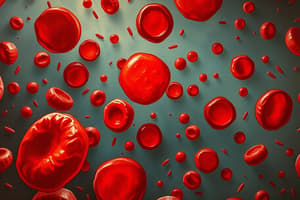Podcast
Questions and Answers
What is the primary function of red blood cells (RBCs)?
What is the primary function of red blood cells (RBCs)?
- Transport oxygen throughout the body (correct)
- Defend against infections
- Clot blood
- Produce hormones
Which white blood cells are primarily responsible for combating bacterial infections?
Which white blood cells are primarily responsible for combating bacterial infections?
- Neutrophils (correct)
- Eosinophils
- Basophils
- Monocytes
What is the normal range for total leukocyte count (TLC) in adults?
What is the normal range for total leukocyte count (TLC) in adults?
- 1,000 to 3,000 cells/mm³
- 4,000 to 11,000 cells/mm³ (correct)
- 2,000 to 5,000 cells/mm³
- 12,000 to 20,000 cells/mm³
What does the Erythrocyte Sedimentation Rate (ESR) measure?
What does the Erythrocyte Sedimentation Rate (ESR) measure?
Which test is used to determine the percentage of red blood cells in blood?
Which test is used to determine the percentage of red blood cells in blood?
Flashcards are hidden until you start studying
Study Notes
Red Blood Cells (RBCs)
- Primary function: Oxygen transport throughout the body
- Lifespan: 120 days
Hemoglobin
- Normal range for adult females: 12-16 g/dL
- Cyanmethemoglobin method is commonly used to measure hemoglobin levels
Platelets
- Responsible for blood clotting
White Blood Cells (WBCs)
- Neutrophils are responsible for combating bacterial infections
- Monocytes are the largest WBC
- Normal range for total leukocyte count (TLC) in adults: 4,000 to 11,000 cells/mm³
- ESR (Erythrocyte Sedimentation Rate) measures inflammation in the body
Hematocrit
- Determines the percentage of RBCs in blood
Studying That Suits You
Use AI to generate personalized quizzes and flashcards to suit your learning preferences.




